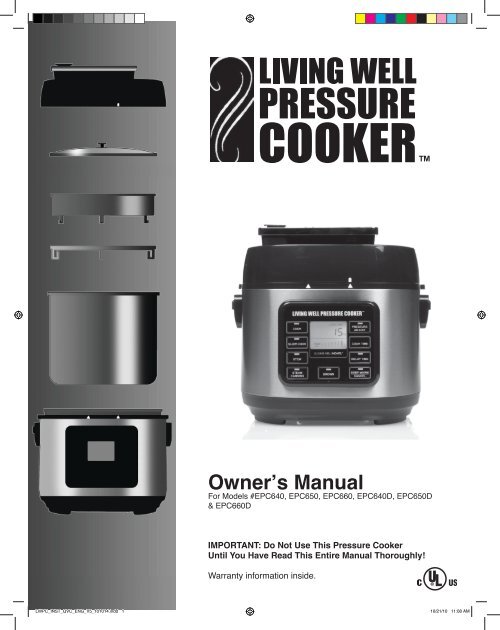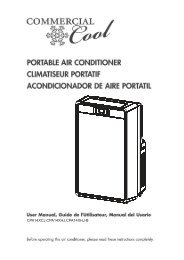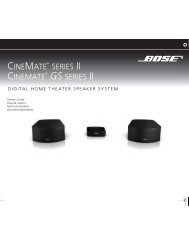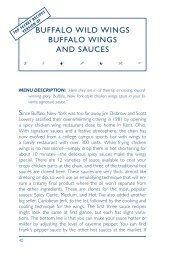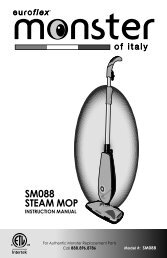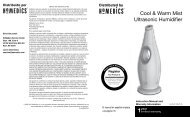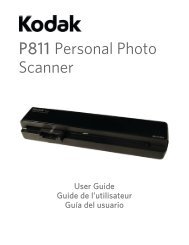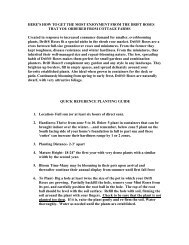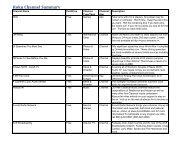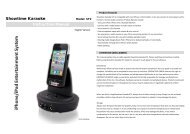Owner's Manual - QVC.com
Owner's Manual - QVC.com
Owner's Manual - QVC.com
You also want an ePaper? Increase the reach of your titles
YUMPU automatically turns print PDFs into web optimized ePapers that Google loves.
Owner’s <strong>Manual</strong><br />
For Models #EPC640, EPC650, EPC660, EPC640D, EPC650D<br />
& EPC660D<br />
Important: Do Not Use This Pressure Cooker<br />
Until You Have Read This Entire <strong>Manual</strong> Thoroughly!<br />
Warranty information inside.<br />
LWPC_INST_<strong>QVC</strong>_ENG_V5_101014.indd 1<br />
10/21/10 11:08 AM
Healthier Cooking Begins Here...<br />
Index<br />
As a new owner of a Living Well Pressure Cooker, you are about to discover what so many other<br />
food aficionados have known for years. Simply, that meals prepared properly in the Living Well<br />
Pressure Cooker taste better, cook faster and retain more natural nutrition than those prepared<br />
using conventional cooking methods.<br />
We have taken the art of pressure cooking to the next level.<br />
Our culinary design division tested numerous materials, metals and cooking surfaces before<br />
deciding on the <strong>com</strong>bination that would work best with the latest digital electronics to create<br />
the Living Well Pressure Cooker.<br />
Once familiar with the system, you’ll find that many of your favorite family recipes can be cooked<br />
perfectly in a fraction of the time. The sealed cooking chamber builds up heat and pressure. The<br />
result ... more flavor stays locked within the food and less energy is wasted in a shorter cooking<br />
time. The “sealed” cooking process eliminates messy stove top spills while “trapping” heat,<br />
making for cooler kitchens and easier cleanups.<br />
The Living Well Pressure Cooker has been designed to provide you and your family with many<br />
years of delicious meals and memories around the dinner table… but before you begin it is very<br />
important that you read this entire manual making certain that you are totally familiar with its<br />
operation and precautions.<br />
Topic<br />
Page<br />
Important Safeguards 1 - 2<br />
Special Features and Built-In Safety Features 3<br />
Living Well Pressure Cooker Parts List 4<br />
General Operating Instructions 5 - 8<br />
Pressure Cooking Guide / Specifications 9<br />
Care and Cleaning 10<br />
Frequently Asked Questions 11<br />
Limited Warranty 12<br />
LWPC_INST_<strong>QVC</strong>_ENG_V5_101014.indd 2-3<br />
10/21/10 11:08 AM
Important Safeguards<br />
When using electrical appliances, basic safety precautions<br />
should always be followed including:<br />
1. Read and follow all instructions carefully.<br />
2. Always be sure the float valve is on correctly before<br />
use. Incorrect assembly may prevent the cooker<br />
from building pressure or allow steam to <strong>com</strong>e out<br />
from the sides of the lid (See page 11 for assembly).<br />
3. Do not touch hot surfaces. Use handles or knobs.<br />
4. To protect against electric shock do not immerse or<br />
rinse cords or plugs in water or other liquid.<br />
5. This appliance should never be operated by children<br />
and special care should be taken when the unit is<br />
in use in their presence.<br />
6. Unplug from outlet when not in use and before<br />
cleaning. Allow to cool before putting on or taking<br />
off parts.<br />
7. Do not operate any appliance with a damaged cord<br />
or plug or after the appliance malfunctions or has<br />
been damaged in any manner. Return appliance<br />
to the nearest authorized service facility for<br />
examination, repair, or adjustment.<br />
8. Do not use any attachments or utensils that were<br />
not re<strong>com</strong>mended or supplied by the manufacturer.<br />
The use of attachments not re<strong>com</strong>mended for use<br />
by the manufacturer may cause serious hazardous<br />
situations including personal injury.<br />
9. Do not use outdoors.<br />
10. Do not let cord hang over edge of table or counter,<br />
or touch hot surfaces.<br />
11. Do not place on or near a hot gas or electric burner,<br />
or in a heated oven.<br />
12. Extreme caution must be used when moving an<br />
appliance containing hot oil or other hot liquids.<br />
13. Always attach plug to appliance first, then plug cord<br />
into the wall outlet. To disconnect, set any control<br />
to ”Off”, then remove plug from wall outlet.<br />
14. Do not use appliance for anything other than its<br />
intended use.<br />
15. This appliance cooks under pressure. Improper use<br />
may result in scalding injury. Make certain unit is<br />
properly closed before operating. See Instructions<br />
For Use.<br />
16. Never fill the unit above the MAX LINE in the Inner<br />
Pot (Illustration #2, page 5). When using foods that<br />
expand during cooking such as rice or dried beans,<br />
follow the recipe for “pressure cooking” those<br />
products, and as a rule of thumb, do not fill the unit<br />
above the “halfway” point. Overfilling may cause<br />
clogging, allowing excess pressure to develop.<br />
See Instructions For Use.<br />
17. Be aware that certain foods, such as applesauce,<br />
cranberries, pearl barley, oatmeal or other cereals,<br />
split peas, noodles, macaroni, rhubarb, and<br />
spaghetti, can foam, froth, sputter, and clog the<br />
pressure release device (steam vent). Recipes<br />
using these items must be followed carefully to<br />
avoid problems.<br />
18. Always check the pressure release devices for<br />
clogs before use.<br />
19. Do not open the pressure cooker until the unit has<br />
cooled and all internal pressure has been released.<br />
If the unit is difficult to open, this indicates that the<br />
cooker is still pressurized – do not force it open.<br />
Any pressure in the cooker can be hazardous. See<br />
Instructions For Use.<br />
20. Do not use this pressure cooker for pressure frying<br />
with oil.<br />
21. This appliance has been designed for use with a<br />
3 prong, grounded, 120V electrical outlet only. Do<br />
not use any other electrical outlet.<br />
22. The Pressure Cooker generates extreme<br />
heat and steam in its operation. All necessary<br />
precautions must be taken to avoid fire,<br />
burns and other personal injury during its operation.<br />
23. When in operation the Pressure Cooker requires<br />
sufficient air space on all sides including top<br />
and bottom. Never operate the unit near any<br />
flammable materials such as dish towels, paper<br />
towels, curtains, paper plates, etc.<br />
24. Always plug the electrical cord directly into the wall<br />
outlet. Never use this unit with an extension cord<br />
of any kind.<br />
25. Anyone who has not fully read and understood<br />
all operating and safety instructions contained in<br />
this manual is not qualified to operate or clean this<br />
appliance.<br />
26. If this unit falls or accidentally be<strong>com</strong>es immersed<br />
in water, unplug it from the wall outlet immediately.<br />
Do not reach into the water!<br />
27. Do not operate this appliance on an unstable<br />
surface.<br />
28. If this appliance begins to malfunction during use,<br />
immediately unplug the cord. Do not use or attempt<br />
to repair a malfunctioning appliance!<br />
29. NEVER FORCE OPEN THE PRESSURE<br />
COOKER. If you need to open the pressure<br />
cooker, press the “KEEP WARM/CANCEL” button<br />
and carefully slide the Rapid Release Button (fig.<br />
4, page 4) to the open position to fully release the<br />
building pressure inside the cooker. Make sure<br />
that all the steam has dissipated from the cooker<br />
and the Float Valve (fig. 6, Page 4) is fully settled<br />
back into the lid shell. Carefully turn the handle<br />
counter clockwise. Always open the lid away from<br />
you to avoid skin contact with any remaining heat<br />
or steam.<br />
30. CAUTION: TO REDUCE RISK OF ELECTRIC<br />
SHOCK, COOK ONLY IN THE REMOVABLE<br />
CONTAINER. Do not immerse the housing or<br />
base in water. Before use, clean the bottom of the<br />
Inner Pot and the surface of the heater plate…<br />
insert the Inner Pot, turning it slightly clockwise<br />
and counterclockwise until you are sure it is sitting<br />
correctly on the heater plate. Failure to do so will<br />
prevent proper operation and may cause damage<br />
to the unit.<br />
31. CAUTION HOT SURFACES. This appliance<br />
generates heat and escaping steam during use.<br />
Proper precautions must be taken to prevent<br />
the risk of personal injury, fires, and damage to<br />
property.<br />
SHORT CORD INSTRUCTIONS<br />
A short power-supply cord is provided to reduce the<br />
risk resulting from be<strong>com</strong>ing entangled in or tripping<br />
over a longer cord. Do not use an extension cord with<br />
this product.<br />
PLASTICIZER WARNING<br />
CAUTION: To prevent Plasticizers from migrating<br />
from the finish of the counter top or table top or other<br />
furniture, place NON-PLASTIC coasters or place mats<br />
between the appliance and the finish of the counter top<br />
or table top. Failure to do so may cause the finish to<br />
darken, permanent blemishes may occur or stains can<br />
appear.<br />
ELECTRIC POWER<br />
If the electrical circuit is overloaded with other<br />
appliances, your appliance may not operate properly.<br />
It should be operated on a dedicated electrical circuit.<br />
Note: This product must be grounded. If it should<br />
malfunction or break down, grounding provides a<br />
path of least resistance for electric current to reduce<br />
the risk of electric shock. This product is equipped<br />
with a cord having an equipment grounding conductor<br />
and a grounding plug. The plug must be plugged<br />
into an appropriate outlet that is properly installed<br />
and grounded in accordance with all local codes and<br />
ordinances.<br />
SAVE THESE INSTRUCTIONS.<br />
SAVE THESE INSTRUCTIONS.<br />
1 FOR HOUSEHOLD USE ONLY.<br />
2<br />
FOR HOUSEHOLD USE ONLY.<br />
LWPC_INST_<strong>QVC</strong>_ENG_V5_101014.indd 4-5<br />
10/21/10 11:08 AM
Special Features & Built-In Safety Features<br />
Living Well Pressure Cooker Parts List<br />
Special Features<br />
1. The Digital Display on your Living Well<br />
Pressure Cooker offers a wide range of choices<br />
including Browning, Slow Cooking, Stewing and<br />
Steaming.<br />
2. Cooking Time and Pressure Levels may<br />
be adjusted to suit any recipe or personal<br />
preference. At the <strong>com</strong>pletion of the cooking<br />
cycle, the unit will automatically shift to the<br />
KEEP WARM mode.<br />
3. Cooking Electronically with Pressure saves time<br />
and energy. For example, rice dishes cook 20%<br />
quicker and save 25% on energy. Most other<br />
dishes average a 40% time saving and 45% on<br />
energy.<br />
4. Digital Pressure Cooking utilizes temperatures<br />
up to 248 O F (120 O C) creating a more sterile<br />
and healthier environment when <strong>com</strong>pared to<br />
traditional cooking methods.<br />
5. The Living Well Pressure Cooker creates a<br />
“sealed environment” that preserves flavor and<br />
“locks in” valuable vitamins and nutrients.<br />
6. Hot kitchens, messy spills and “boil-over” are a<br />
thing of the past.<br />
7. The Living Well Pressure Cooker has a BROWN<br />
mode that allows you to sear or brown food using<br />
the Inner Pot before cooking under pressure.<br />
8. The Rapid Release feature allows you to lower<br />
pressure quickly and <strong>com</strong>pletely. To do so,<br />
carefully slide the Rapid Release Button (fig 4.,<br />
page 4) forward in short bursts at first. After initial<br />
short bursts, leave the button in the full forward<br />
position until all pressure has escaped and the<br />
digital pressure indicator does not register.<br />
CAUTION: During this process protect your skin<br />
from any contact with escaping steam.<br />
9. The STEAM mode heats cooking liquid in the<br />
Inner Pot to a boil in a matter of minutes, for<br />
steaming and cooking an endless variety of<br />
foods.<br />
10. The KEEP WARM mode holds and keeps<br />
cooked food warm for an unlimited period of<br />
time. Foods kept at KEEP WARM mode for<br />
periods beyond 4 hours may loose their good<br />
flavor and texture.<br />
11. Cooker Housing is both attractive and<br />
functional.<br />
Built-In Safety Features<br />
1. Lid Safety Device: Prevents pressure build-up<br />
if lid is not closed properly and prevents lid from<br />
opening until all pressure is released.<br />
2. Pressure and Temperature Sensor<br />
Controls: Maintain even heat and pressure<br />
by automatically activating or deactivating the<br />
power supply.<br />
3. “Back-up” Safety Release Valve: Should<br />
the Temperature/Pressure Sensor device<br />
malfunction, causing pressure to build<br />
beyond maximum setting, the “Back-Up” will<br />
automatically “kick in” and release the built up<br />
pressure.<br />
4. “Clog Resistant” Feature: Prevents food from<br />
blocking the steam release port.<br />
5. “Spring-Loaded” Safety Pressure Release:<br />
Should all safety features listed above fail, this<br />
“spring-loaded” device located beneath the<br />
heating element will automatically lower the<br />
Inner Pot, causing it to separate automatically<br />
from the Rubber Gasket (fig. 3, page 4). This will<br />
enable the steam and pressure to automatically<br />
escape around the pot Lid, avoiding a dangerous<br />
situation.<br />
6. Temperature“Cut-Off” Device: Should the unit<br />
malfunction and cause the internal temperature<br />
to rise beyond the “Safe” limit, this device will cutoff<br />
the power supply and will not automatically<br />
reset.<br />
3<br />
Pressure Valve<br />
Rapid Release<br />
Button<br />
11 Lid Handle<br />
Condensation<br />
Collector<br />
4<br />
12<br />
10<br />
2<br />
5<br />
Lid Shell<br />
Rubber Gasket/Lid Liner<br />
1 Inner Pot<br />
Outer Pot<br />
Support Ring<br />
LCD<br />
Control Panel<br />
AC Cord<br />
9<br />
Float Valve<br />
Safety Valve<br />
(located on<br />
underside of Lid)<br />
Housing Handle<br />
Housing<br />
IMPORTANT: Your Living Well Pressure Cooker TM has been shipped with the <strong>com</strong>ponents shown above. Check<br />
everything carefully before use. If any part is missing or damaged do not use this product and contact shipper using the customer<br />
service number located on the back of the owner’s manual.<br />
3 4<br />
6<br />
7<br />
Sensor<br />
Heater Plate<br />
Base<br />
LWPC_INST_<strong>QVC</strong>_ENG_V5_101014.indd 6-7<br />
10/21/10 11:08 AM
General Operating Instructions<br />
1<br />
2<br />
BEFORE THE FIRST USE<br />
Before using the Living Well Pressure Cooker for the first time, wash the Inner Pot, the Lid and the<br />
Rubber Gasket/Lid Liner (pictured below #1) with warm soapy water. The Rubber Gasket/Lid Liner<br />
should first be removed from the Lid using the small metal knob on its surface. Rinse with clean water<br />
and dry thoroughly.<br />
Make sure the Rubber Gasket/Lid Liner is seated properly inside the Lid. To ensure correct fitting of<br />
the Rubber Gasket, fill the Inner Pot (pictured below #2) with water about 2/3 full, place the Lid on the<br />
cooker (Pictured below #3), then slide the Rapid Release Button to the CLOSED position and run on<br />
COOK mode for 15 minutes. Wait 15 minutes, then release pressure by sliding the Rapid Release<br />
Button to the OPEN position (Pictured below #4). The Float Valve will drop. Let the appliance cool to<br />
room temperature. Pour out the water. Rinse and towel dry the Inner Pot. The Pressure Cooker is now<br />
ready for use.<br />
#1 Lid with Rubber Gasket/Lid Liner<br />
1. To remove the Rubber Gasket/Lid Liner Pull<br />
on the small knob located on the face of the Liner.<br />
The Rubber Gasket should be separated from the<br />
Lid Liner for proper cleaning.<br />
2. To replace the Rubber Gasket/Lid Liner Align<br />
the center hole in the Liner with the raised metal<br />
shaft located in the center underside of the Lid and<br />
press firmly into place.<br />
#2 Inner Pot<br />
Note Max Fill Line<br />
2/3<br />
BEFORE EACH USE<br />
For best results, always check that the Pressure Valve (fig.5, page 4), Float Valve (fig.6, page 4), Rapid<br />
Release Button (fig.4, page 4), Safety Valve (fig. 7, page 4) and Rubber Gasket/Lid Liner (fig.3, page<br />
4) are in good working order and that there are no foreign particles blocking the Valve openings on the<br />
underside of the Lid. See CARE & CLEANING INSTRUCTIONS.<br />
For General Use<br />
• Never load Inner Pot above the MAX line. Rotate the Inner Pot to make certain that it is seated<br />
properly on the Heating Plate.<br />
• Always be certain the Pressure Valve is free floating and clear of any obstructions.<br />
• Attach the AC Cord to the base of the unit then plug the AC Cord into a dedicated 120V wall outlet.<br />
• Steam and pressure must be released <strong>com</strong>pletely from the Cooker before the Lid will open. To do this,<br />
carefully slide the Rapid Release Button forward (Illustration #4 opposite page) until all pressure has<br />
escaped and the digital pressure indicator does not register.<br />
CAUTION: During this process protect your skin from any contact with escaping steam.<br />
• Press down gently on Lid and turn clockwise until Lid meets resistance... lift carefully and place<br />
aside. Avoid personal injury resulting from hot unit surfaces and dripping liquids.<br />
Note: The “cook times” shown in the recipe booklet do not include the additional time needed to<br />
pressurize the unit before cooking begins. Full pressurization could take up to 17 minutes.<br />
POWER SURGE PROTECTION FEATURE<br />
Place Inner Pot into the unit. Never load Inner Pot above<br />
the MAX line. Rotate the Inner Pot to make certain that it is<br />
seated properly.<br />
Place Cooker Lid on Cooker with Lid Handle and Pressure<br />
Valve pointed to the “10 o’clock” position (fig. A). Rotate Lid<br />
counterclockwise until you feel a click and the symbols on the<br />
Lid and Support Ring are properly aligned (fig. B).<br />
#3 Placing The Lid On The Cooker<br />
Fig. A<br />
Fig. B<br />
Lid Open<br />
Lid Close<br />
The Living Well Pressure Cooker has a back-up feature to prevent malfunction in the event of a power<br />
surge. In the event of a system shut down caused by a power surge, unplug the cooker allow it to “clear”<br />
for 1 hour before plugging it back into the outlet.<br />
SPRING LOADED CAKE PAN ASSEMBLY<br />
Not Included With All Models<br />
#4 Handle with Float Valve and Rapid Release Button<br />
5 6<br />
Step 1<br />
Place the cake pan on its base.<br />
(Make sure the pan’s latch is open<br />
and fits securely into its base.)<br />
Step 2<br />
Secure the latch.<br />
Step 3<br />
Cover with lid.<br />
LWPC_INST_<strong>QVC</strong>_ENG_V5_101014.indd 8-9<br />
10/21/10 11:08 AM
General Operating Instructions (continued)<br />
When the unit is first plugged in,<br />
the LED background color will be GREEN.<br />
When a cooking process is selected such<br />
as COOK, the small red indicator light in<br />
the COOK panel will blink for 8 seconds,<br />
then the LED background color will turn<br />
RED. The Panel will remain RED until the<br />
cooking process is <strong>com</strong>plete. The Panel<br />
will then turn YELLOW, indicating that<br />
the unit is in the KEEP WARM mode until<br />
cancelled. (Fig. A)<br />
Push the COOK Button on the Control Panel (Fig.B).<br />
The LED will change to the COOK mode default<br />
setting, 15 minutes cook time with a pressure<br />
setting of 40 kPa* (Fig.C). The LED screen will<br />
change color from GREEN to RED.<br />
Push the SLOW COOK Button on the Control Panel<br />
(Fig.D). The LED will change to the SLOW COOK<br />
mode default setting, 6 Hours cook time (Fig.E).<br />
The LED screen will change color from GREEN<br />
to RED.<br />
Digital Control Panel (overview)<br />
The Living Well Pressure Cooker has up to eight basic cooking modes that may be used alone<br />
or in <strong>com</strong>bination to produce an infinite variety of results. The Quick Start Guide<br />
supplied with this unit provides Step-By-Step instructions.<br />
Fig. B<br />
Fig. D<br />
Fig. A<br />
Fig. C<br />
Fig. E<br />
Push the STEAM/CANNING Button on the Control<br />
Panel (Fig.H). The LED will change to the STEAM/<br />
CANNING mode default setting, 30 Minutes (Fig.I).<br />
The Led screen will change color from GREEN<br />
to RED.<br />
Push the BROWN Button on the Control Panel<br />
(Fig.J). The LED will change to the BROWN mode<br />
default setting, 30 Minutes (Fig.K). The LED screen<br />
will change color from GREEN to RED.<br />
Push the PRESSURE ADJUST Button on the Control<br />
Panel (Fig.L). The LED will change to 15 minutes<br />
cook time with a pressure setting of 40 kPa.<br />
Continue holding the PRESSURE ADJUST button<br />
until the desired kPa setting is reached (20kPa<br />
- 80kPa). Once the Preset Pressure is reached,<br />
The cook time will countdown. When cook time<br />
reaches “0” the unit will automatically go to Keep<br />
Warm. It will stay warm until you select CANCEL.<br />
Push the COOK TIME Button to change the default<br />
time (Fig.M), in any mode ... the time will start from<br />
the default setting for that mode, run up to maximum<br />
minute or hour setting, then begin again at a<br />
lower setting.<br />
Push the DELAY TIME Button - and your meal<br />
will cook at a later time (Fig.N).<br />
Fig. H<br />
Fig. J<br />
Fig. L<br />
Fig. I<br />
Fig. K<br />
Fig. M<br />
Push the STEW Button on the Control Panel (Fig.F).<br />
The LED will change to the STEW mode default<br />
setting, 30 minutes cook time with a pressure<br />
setting of 80 kPa (Fig.G). The LED screen will<br />
change color from GREEN to RED.<br />
*kPa as a unit of pressure measurement, is widely<br />
used throughout the world instead of the “pounds<br />
per square inch, PSI” method. kPa to PSI ratio is<br />
approximately 7kPa to 1PSI. For example 2PSI is<br />
Fig. F<br />
Fig. G<br />
Pushing the KEEP WARM / CANCEL Button<br />
(Fig.O) - while the unit is in a cooking cycle<br />
KEEP WARM/CANCEL will stop the cooking cycle.<br />
When a cooking cycle runs its full course, the<br />
unit automatically goes into the KEEP WARM<br />
mode. When the unit is in the KEEP WARM mode,<br />
pressing the KEEP WARM/CANCEL button will<br />
CANCEL the KEEP WARM operation. Pressing the<br />
KEEP WARM/CANCEL button when the unit is in<br />
neutral (Green LED) mode mode will reset the unit<br />
to the KEEP WARM mode.<br />
7 equal to 14kPa.<br />
8<br />
Fig. N<br />
Fig. O<br />
LWPC_INST_<strong>QVC</strong>_ENG_V5_101014.indd 10-11<br />
10/21/10 11:08 AM
Pressure Cooking Guide / Specifications<br />
Care and Cleaning<br />
NOTE: All pressure cooking modes require the addition of liquid in some form (water,<br />
stock, etc.). Unless you are familiar with the pressure cooking process, follow recipes<br />
carefully for liquid addition suggestions. A glass lid has been provided to be used during<br />
the Slow Cook, Brown, Steam/Canning modes. Never fill inner pot above MAX line.<br />
Always use Rapid Release button to lower pressure quickly.<br />
Meats Liquid / Cups Approximate Minutes Pressure Setting<br />
Beef/Veal, roast or brisket 3-4 35-40 High<br />
Beef Meatloaf, 2 lbs 1 5-10 Medium<br />
Beef, Corned 4 50-60 High<br />
Pork, roast 1 40-45 High<br />
Pork, ribs, 2 lbs. 3 15 High<br />
Leg of Lamb 2-4 35-40 High<br />
Chicken, whole, 2-3 lbs. 3-4 15-20 High<br />
Chicken, pieces, 2-3 lbs. 3-4 15-20 High<br />
Cornish Hens, two 1 15 High<br />
Meat/Poultry Soup/Stock 4-6 10-15 High<br />
Vegetables Liquid / Cups Approximate Minutes Pressure Setting<br />
Asparagus, thin whole 1 1 -1 1/2 High<br />
Beans, fava 1 4 High<br />
Beans, green 1 2-3 High<br />
Beans, lima 1 2 High<br />
Beets, medium 1 10 High<br />
Broccoli, pieces 1 3 High<br />
Brussel sprouts, whole 1 4 High<br />
Carrots, 1-inch pieces 1 4 High<br />
Corn, on-the-cob 1 3 High<br />
Onions, whole 1 2 High<br />
Potatoes, 1 1/2” chunks 1 6 High<br />
Potatoes, whole, medium 1 10-11 High<br />
Squash, acorn, halved 1 7 High<br />
Squash, summer, zucchini 1 4 High<br />
Seafood / Fish Liquid / Cups Approximate Minutes Pressure Setting<br />
Clams 1 2-3 Medium<br />
Lobster, 1 1/2 - 2 lbs. 1 2-3 Medium<br />
Shrimp 1 1-2 Medium<br />
Fish, Soup or Stock 1-4 5-6 High<br />
Unit Specifications<br />
Model Supply Power Rated Power Capacity of Inner Pot Working Pressure Safety Working<br />
Pressure<br />
EPC640D AC 120V 60HZ 1000W 4 LITRES 10-80 kPa 96-110 kPa<br />
EPC650D AC 120V 60HZ 1000W 5 LITRES 10-80 kPa 96-110 kPa<br />
EPC660D AC 120V 60HZ 1000W 6 LITRES 10-80 kPa 96-110 kPa<br />
CLEANING THE SAFETY DEVICES: In addition to the gasket, the other safety devices on the pressure cooker must also be<br />
cleaned after each use.<br />
THE PRESSURE VALVE: To remove the Pressure Valve, simply pull up and valve will release from it’s spring lock mechanism.<br />
Apply mild detergent and wash it under warm running water. After cleaning, check to see that the interior spring-loaded part<br />
moves freely by pressing down on it. Put the Pressure Valve back in place by pushing it down onto the spring-loaded mechanism.<br />
This appliance requires little maintenance. It contains no user serviceable parts. Do not try to repair it yourself. Contact<br />
customer service for qualified repair information.<br />
TO CLEAN: After use, unplug unit and allow to cool <strong>com</strong>pletely before cleaning. The Pressure Cooker must be cleaned thoroughly<br />
after each use in order to avoid staining caused by a build-up of food or cooking residue.<br />
DO NOT POUR COLD WATER INTO A HOT PRESSURE COOKER.<br />
Note: To ensure safe operation of this pressure cooker, strictly follow the cleaning and maintenance instructions after each use,<br />
should a tiny fragment of food (such as a grain of rice or pea shell) remain in the unit, it could prevent the safety devices from<br />
operating during subsequent use.<br />
IMPORTANT: Always remove the Pressure Valve and clean the opening with pin to remove any blockage that might have occurred<br />
during the cooking process. This must be done after each use. The removable cooking pot and Lid are immersible for<br />
cleaning. Rinse cooking pot and Lid under hot running water. Use only a mild liquid detergent and a soft cloth, sponge or nylon<br />
scrubber for cleaning. Do not use abrasive powders, bicarbonate of soda or bleach. Do not use scouring pads.<br />
WIPE BASE AFTER EACH USE WITH A SOFT, DAMP CLOTH OR SPONGE, MAKING SURE ALL FOOD RESIDUE IS<br />
REMOVED. DO NOT IMMERSE BASE IN WATER<br />
When cleaning the Lid, the Rubber Gasket/Lid Liner (page 5, Illustration #1) must be removed and washed separately with a<br />
sponge or soft cloth and warm, soapy water.<br />
• Unplug and let the Pressure Cooker cool to room temperature before cleaning.<br />
• Wash the removable pot with warm, soapy water and clean with a soft cloth or sponge. Rinse off with clean water and<br />
towel dry.<br />
• Remove the Rubber Gasket/Lid Liner (page 5, Illustration #1) from the underside of the self-locking Lid. Wash all with<br />
warm, soapy water and clean with a soft cloth or sponge. Rinse off with clean water and towel dry.<br />
• The Rubber Gasket must always be properly positioned on the underside of the Lid. Check periodically to make sure that<br />
it is clean, flexible and not torn. If damaged, do not use this unit.<br />
• Wipe the mirror finished outer Housing with a damp soft cloth or sponge (glass cleaner gives<br />
housing a brilliant lustre).<br />
• Never use harsh chemical detergents, scouring pads or powders on any of the parts or <strong>com</strong>ponents.<br />
• Always check that the Pressure Valve and Float Valve are in good working order and debris free.<br />
Note: The Rubber Gasket must be replaced every year, or sooner if necessary. The Rubber Gasket may also need<br />
replacing if Pressure Cooker is not used for a long period of time, as it can harden from disuse, making it unable to<br />
form an airtight seal. The Rubber Gasket must be replaced only with another one of the correct type and size for this<br />
Pressure Cooker.<br />
9 10<br />
LWPC_INST_<strong>QVC</strong>_ENG_V5_101014.indd 12-13<br />
10/21/10 11:08 AM
Frequently Asked Questions<br />
1. DOES THE PRESSURE COOKER HAVE LEAD IN IT?<br />
No!<br />
2. WHAT TYPE OF STEEL IS THE UNIT MADE OF?<br />
Stainless Steel<br />
3. IS IT NORMAL TO HAVE STEAM COME OUT THE SIDES?<br />
If there is steam <strong>com</strong>ing out the sides and the button on top of the Lid is in the closed position, then the Lid<br />
has not seated. This sometimes happens when the unit is new. If the gasket is in place try pushing down on<br />
the Lid. This should seal the Lid and the steam should stop <strong>com</strong>ing out. It is also important to be sure the<br />
Float Valve is assembled correctly. Incorrect assembly may cause steam to <strong>com</strong>e out the sides or prevent<br />
pressure from building. The Float Valve should be able to move up and down freely only stopping when the<br />
silicon gasket meets the Lid. It is however normal for condensation to appear in the condensation collector.<br />
See illustration below for assembly.<br />
1. Hold the head of the Float Valve and insert<br />
the fluted end into the hole in the Lid of<br />
the Pressure Cooker. Press and hold the<br />
head of the Float Valve tightly in place and<br />
reverse the Lid to the stainless steel side.<br />
2. The fluted end of<br />
the Float Valve should<br />
be sticking out of the<br />
inside of the Lid.<br />
4. HOW DO YOU ASSEMBLE/DISASSEMBLE THE UNIT?<br />
See Diagram on page 4 of this manual.<br />
3. Place the silicon<br />
gasket onto the<br />
fluted end of the<br />
Float Valve so it sits<br />
in the groove.<br />
5. WHY WOULD THE LID COME OFF WHEN IT SHOULDN’T?<br />
It would only <strong>com</strong>e off if there was no pressure inside, see answer to question 3 above.<br />
4. The Float Valve should be able to move up<br />
and down freely only stopping when the<br />
silicon gasket meets the Lid.<br />
6. WHAT IS THE DEFAULT TIME?<br />
Each cooking mode has a default time that appears as soon as you select that desired mode button. Before<br />
the Default Time “minute count down” clock begins, the unit must first reach the proper pressure and or<br />
temperature for that mode.<br />
7. How long does it take for the unit to reach full pressure and for the cook time<br />
CLOCK to start a count down?<br />
Up to 17 minutes.<br />
8. Can you change the cook time, DELAY TIME OR PRESSURE so that it is less OR MORE<br />
than the default SETTING?<br />
Yes! See instructions in the Quick Start Guide supplied with this unit.<br />
9. CAN YOU LEAVE THE UNIT ON WHILE AT WORK?<br />
Yes!<br />
Manufacturer’s Limited Warranty<br />
The manufacturer warrants that your Living Well Pressure Cooker is free of defects in materials and<br />
workmanship and will, at its option, repair or replace any defective Living Well Pressure Cooker<br />
that is returned to it. All parts and <strong>com</strong>ponents of the Living Well Pressure Cooker are warranted<br />
for 60 days from the original date of purchase. This warranty is valid only in accordance with the<br />
conditions set forth below:<br />
1. Normal wear and tear are not covered by this warranty. This warranty applies to consumer<br />
use only, and is void when the product is used in a <strong>com</strong>mercial or institutional setting.<br />
2. The warranty extends only to the original consumer purchaser and is not transferable. In<br />
addition, proof of purchase must be demonstrated. This warranty is void if the product has<br />
been subject to accident, misuse, abuse, improper maintenance or repair, or unauthorized<br />
modification.<br />
3. This limited warranty is the only written or express warranty given by the manufacturer. Any<br />
implied warranty of merchantability or fitness for a particular purpose on this product is<br />
limited in duration to the duration of this warranty. Some states do not allow limitations on<br />
how long an implied warranty lasts, so the above limitation may not apply to you.<br />
4. Repair or replacement of the product (or, if repair or replacement is not feasible, a refund<br />
of the purchase price) is the exclusive remedy of the consumer under this warranty. The<br />
manufacturer shall not be liable for any incidental or consequential damages for breach<br />
of this warranty or any implied warranty on this product. Some states do not allow the<br />
exclusion or limitation of incidental or consequential damages,<br />
so the above limitation or exclusion may not apply to you.<br />
5. This warranty gives you specific legal rights, and you may also have other rights which vary<br />
from state to state.<br />
Procedure for Warranty Repairs or Replacement:<br />
If warranty service is necessary, the original purchaser must pack the product securely and send<br />
it postage paid with a description of the defect, proof of purchase, and a check or money order<br />
for $24.99 to cover return postage and handling to the following address: Living Well Pressure<br />
Cooker, P.O. Box 3007, Wallingford, CT 06492.<br />
10. CAN YOU PUT FROZEN FOODS IN WITHOUT DEFROSTING?<br />
Yes, remember to add an extra 10 minutes for frozen meats.<br />
11 12<br />
LWPC_INST_<strong>QVC</strong>_ENG_V5_101014.indd 14-15<br />
10/21/10 11:08 AM
We are very proud of the design<br />
and quality of our<br />
This product has been manufactured<br />
to the highest standards.<br />
Should you have any problem,<br />
our friendly customer service staff<br />
is here to help you.<br />
1-973-287-5163<br />
Distributed By:<br />
Tristar Products, Inc.<br />
Fairfield, NJ 07004<br />
© 2010 Tristar Products, Inc.<br />
LWPC_INST_<strong>QVC</strong>_ENG_V5_101014<br />
LWPC_INST_<strong>QVC</strong>_ENG_V5_101014.indd 16<br />
10/21/10 11:08 AM


